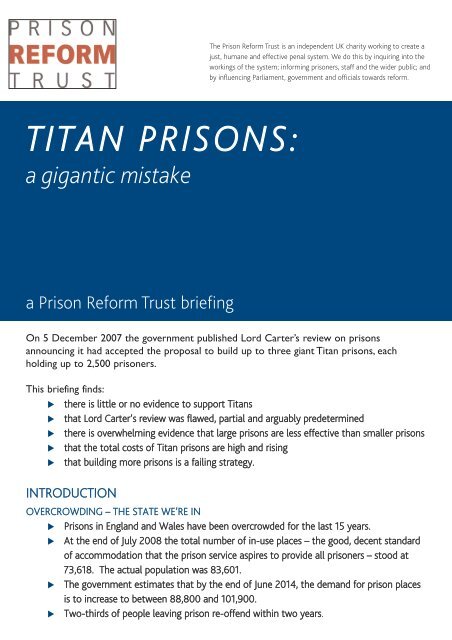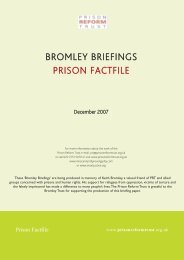Titan Prisons: A Gigantic Mistake - Prison Reform Trust
Titan Prisons: A Gigantic Mistake - Prison Reform Trust
Titan Prisons: A Gigantic Mistake - Prison Reform Trust
Create successful ePaper yourself
Turn your PDF publications into a flip-book with our unique Google optimized e-Paper software.
The <strong>Prison</strong> <strong>Reform</strong> <strong>Trust</strong> is an independent UK charity working to create a<br />
just, humane and effective penal system. We do this by inquiring into the<br />
workings of the system; informing prisoners, staff and the wider public; and<br />
by influencing Parliament, government and officials towards reform.<br />
TITAN P R I S O N S :<br />
a gigantic mistake<br />
a <strong>Prison</strong> <strong>Reform</strong> <strong>Trust</strong> briefing<br />
On 5 December 2007 the government published Lord Carter’s review on prisons<br />
announcing it had accepted the proposal to build up to three giant <strong>Titan</strong> prisons, each<br />
holding up to 2,500 prisoners.<br />
This briefing finds:<br />
there is little or no evidence to support <strong>Titan</strong>s<br />
that Lord Carter’s review was flawed, partial and arguably predetermined<br />
there is overwhelming evidence that large prisons are less effective than smaller prisons<br />
that the total costs of <strong>Titan</strong> prisons are high and rising<br />
that building more prisons is a failing strategy.<br />
INTRODUCTION<br />
OVERCROWDING – THE STATE WE’RE IN<br />
<strong><strong>Prison</strong>s</strong> in England and Wales have been overcrowded for the last 15 years.<br />
At the end of July 2008 the total number of in-use places – the good, decent standard<br />
of accommodation that the prison service aspires to provide all prisoners – stood at<br />
73,618. The actual population was 83,601.<br />
The government estimates that by the end of June 2014, the demand for prison places<br />
is to increase to between 88,800 and 101,900.<br />
Two-thirds of people leaving prison re-offend within two years.
LORD CARTER’S PRISONS REVIEW<br />
In June 2007, Lord Carter was asked by the government to consider options for aligning the supply and demand of<br />
prison places and to make recommendations on how this could be achieved. Or, as Justice Secretary Jack Straw put<br />
it, Carter looked ‘at the potential economies and benefits from large prisons. He was employed to do that.’ 1<br />
Lord Carter’s report ‘Securing the Future’ was published on 5 December 2007. Its central recommendation was for<br />
a significant acceleration and expansion of the current building programme to meet ‘the unprecedented demand for<br />
prison places’. 2 At the heart of this expansion would lie three ‘state of the art’ <strong>Titan</strong> prisons, each holding around<br />
2,500 people. This recommendation was primarily driven by cost – the argument of economies of scale.<br />
The government immediately accepted Lord Carter’s proposals and announced a programme for building 10,500<br />
prison places to be delivered by 2014. These places would be in addition to the commitment to build 9,500 prison<br />
places previously announced. 3 The government’s aim is to achieve an overall capacity of 96,000 places by 2014; a<br />
total reached through the addition of these new places and the closure of some old and ineffective prisons. 4<br />
The proposal has been ‘almost universally condemned’ 5 by everyone from politicians and the Chief Inspector of<br />
<strong><strong>Prison</strong>s</strong>, to both the <strong>Prison</strong> Governors’ Association and <strong>Prison</strong> Officers’ Association. There have been widespread<br />
calls for further debate and examination of the case for proceeding with <strong>Titan</strong>s.<br />
In response, on 30 January 2008 Gordon Brown confirmed that ‘we will go ahead with these prisons following the<br />
consultation … that will take place.’<br />
TITAN PRISONS: PROPOSALS<br />
Lord Carter has recommended the building of three so-called <strong>Titan</strong> prisons as a key part of the strategy for the<br />
modernisation of the prison estate.<br />
Each <strong>Titan</strong> prison would provide up to 2,500 places, comprising five units of approximately 500 offenders. Each unit<br />
would hold different segments of the prison population.<br />
Carter argues that these prisons will be ‘state of the art’ institutions ‘offering better value for money and much<br />
improved chances of reducing re-offending and crime’. Both of these claims in favour of <strong>Titan</strong>s are made with little or<br />
no evidence.<br />
Conversely, Carter has acknowledged from the outset the disadvantages of large prisons, reminding us why prisons<br />
holding 2,500 people have never before been considered:<br />
There are some operational challenges associated with large prisons, including the possibility of<br />
large scale disturbance, the difficulty in meeting the needs of specific groups of prisoners (e.g.<br />
female and young offenders) and the management complexities associated with a large staff<br />
complement and challenges of managing a number of potentially different prisoner segments on<br />
the same site. 6<br />
The government plans to build these prisons in London, the West Midlands and the north-west of England – areas<br />
where demand far outstrips supply.<br />
The <strong>Titan</strong>s consultation paper appears to have excluded any meaningful debate on whether <strong>Titan</strong>s are in fact the right<br />
option.The government is purely focusing on ‘the development of <strong>Titan</strong> prisons and how these will fit with the<br />
overall prisons estate strategy’. 7 There is no opportunity to raise any objections to the <strong>Titan</strong> policy itself.<br />
TITANS: NO EVIDENCE OR SUPPORT<br />
We are … very concerned that Lord Carter’s review does not explain in any detail the evidence<br />
or the reasoning behind his conclusions.<br />
It is clear that the substantial investment now being made on the basis of those conclusions is<br />
not based on solid foundations.<br />
House of Commons Justice select committee. 8 2
NO EVIDENCE<br />
Both Lord Carter’s review and the Ministry of Justice’s consultation paper fail to present any real evidence in support<br />
of the <strong>Titan</strong>s approach.What evidence Carter does present has been described as ‘inadequate and highly misleading’. 9<br />
Between December 2007 and the publication of the Ministry of Justice’s consultation paper on 5 June 2008 there<br />
was a distinct change in tone in the government’s description of the proposed building programme.The justification<br />
for <strong>Titan</strong>s shifted from addressing the ‘urgent need for prison accommodation’ 10 to emphasising the place <strong>Titan</strong><br />
prisons would play in building a ‘modern prison and criminal justice system’. 11 By the time the consultation was<br />
launched the focus had moved again, to how ‘<strong>Titan</strong>s can strengthen our ability to provide … comprehensive<br />
rehabilitation to individual offenders.’ 12<br />
It seems as though the government embarked on the search for arguments in favour of <strong>Titan</strong>s only after deciding to<br />
go ahead.<br />
LORD CARTER’S REVIEW: CONCERNS<br />
Fundamental questions have been asked by the House of Commons Justice select committee and others regarding<br />
Lord Carter’s role, the inadequate and selective evidence base for his proposals and the manner in which he<br />
conducted his inquiry.<br />
Arguably, Lord Carter’s position as head of the inquiry was inappropriate owing to his involvement in previous policy<br />
recommendations. Indeed, one leading expert, Professor Carol Hedderman, 13 questioned Carter’s objectivity:<br />
Surely the reader has a right to know that the man in charge of the latest review recommended<br />
most of the recent changes which were expected to limit the growth in prisoner numbers and<br />
that those changes have not had the effects he anticipated 14<br />
A PREDETERMINED OUTCOME<br />
Given the scale, impact and cost of <strong>Titan</strong>s it is alarming that the consultation carried out by Lord Carter was so<br />
limited in its breadth and depth. The Justice select committee secured from Lord Carter a list of the people and<br />
organisations he consulted over the course of his inquiry, including details of whether <strong>Titan</strong>s were discussed. Dates<br />
given to the committee indicate the inquiry may have got under way prior to it being publicly announced.<br />
Lord Carter held meetings with representatives of fifty-one organisations, agencies and individuals during the inquiry.<br />
<br />
<br />
<br />
Only 17 were consulted on <strong>Titan</strong>s.<br />
Of these, nine were private companies – construction firms and private prison operators with a clear<br />
vested interest in a prison building programme.<br />
Six were government departments.<br />
The final two were the <strong>Prison</strong> Officers’ Association and the <strong>Prison</strong> Governors’ Association. However, Paul Tidball,<br />
President of the PGA has since stated that they ‘were not actually consulted about [<strong>Titan</strong>s]’ and that ‘it was the<br />
biggest rabbit that came out of the hat on the day the Carter was announced.’ 15<br />
It is arguably even more significant to see who was excluded from these discussions. Perhaps the most remarkable<br />
omission was HM Chief Inspector of <strong><strong>Prison</strong>s</strong>,Anne Owers, whose involvement in the inquiry was limited to an hourlong<br />
coffee, at her request.As Paul Tidball puts it,‘there cannot be more of an expert than the Chief Inspector.’ 16<br />
The validity and the value of Lord Carter’s findings were heavily criticised by the Justice select committee which<br />
concluded it agreed with concerns that the ‘review was based on wholly inadequate consultation and a highly<br />
selective evidence base.’ 17 It is difficult to avoid the conclusion that the recommendation for <strong>Titan</strong>s was fixed early in<br />
the review period, if not already predetermined at the outset, irrespective of the evidence available or presented to<br />
the review team.<br />
3
WIDESPREAD OPPOSITION<br />
HM Chief Inspector of <strong><strong>Prison</strong>s</strong>:<br />
Anne Owers, the Chief Inspector of <strong><strong>Prison</strong>s</strong>, described the report as a ‘missed opportunity’:<br />
On the horizon loom the <strong>Titan</strong>s – 2,500-strong prison complexes, flying in the face of our, and<br />
others’, evidence that smaller prisons work better than large ones. 18<br />
My fear is that what we will get is more prisoners and worse prisons, a focus on efficiency rather<br />
than effectiveness, and also a moving away of resources from those things which are currently<br />
leading to the rise in prisoner numbers … I would have preferred to see a more transparent and<br />
broader inquiry. 19<br />
<strong>Prison</strong> Governors’ Association:<br />
The <strong>Prison</strong> Governors’ Association ‘are underwhelmed by the case’ for <strong>Titan</strong> prisons, feeling that the main drivers are<br />
claims to economies of scale, and assumptions that ‘there is a better chance of getting planning permission to build it<br />
next-door to a Tesco at a motorway’ than a local prison connected to the community. 20<br />
The association also shares Lord Woolf’s fear that bigger prisons mean ‘bigger disorder’ and gang culture.<br />
<strong>Prison</strong> Officers’ Association:<br />
The <strong>Prison</strong> Officers’ Association’s principal concern is that ‘the <strong>Titan</strong> idea seems one borne out of warehousing<br />
rather than one of rehabilitation and correcting those causes of re-offending.’ 21 It also fears such a resource-draining<br />
initiative at a time when a 3% year-on-year efficiency saving is being imposed on the <strong>Prison</strong> Service.According to<br />
National Chairman, Colin Moses,‘this will lead to staff cuts, prisoners being locked in their cells for longer periods,<br />
offending behaviour programmes cancelled and ultimately prisoners re-offending upon release.’ 22<br />
HM Chief Inspector of Probation:<br />
HM Chief Inspector of Probation Andrew Bridges described Lord Carter’s prison building proposals and their<br />
endorsement by the government as a ‘high-risk option’ where a small incapacitating effect could be achieved at a very<br />
high cost. 23<br />
Independent Monitoring Boards:<br />
These boards comprise members of the public appointed by the Secretary of State for Justice who monitor the dayto-day<br />
life in their local prison and ensure that proper standards of care and decency are maintained.The President<br />
of the IMB National Council, Rt Revd Dr Peter Selby believes <strong>Titan</strong>s are so flawed they are unlikely ever to be built:<br />
At the moment it is still policy, and I don’t think that anyone is going to disown the policy<br />
because they would have to admit that last year’s Carter report on the prison system was wrong.<br />
So I think they are going to go on saying that we are going to be building titan prisons, but I<br />
would be very surprised if they do. 24<br />
A statement issued by the IMB National Council expressed ‘fundamental doubts’ about the <strong>Titan</strong> proposals and<br />
described the consultation as a ‘fait accompli’. 25<br />
Cross-party opposition:<br />
The <strong>Prison</strong> Policy Group, consisting of senior MPs and Peers from all three parties, has produced a discussion paper<br />
on the proposals put forward by Lord Carter. It believes that ‘these proposals should not go ahead without much<br />
more debate and consideration of other options’:<br />
The move to so-called <strong>Titan</strong> prisons each holding 2,500 prisoners goes against all that is known<br />
about the need to make prisons as rehabilitative as possible and to hold prisoners near their<br />
homes so they can maintain contact with their families. 26<br />
Nick Herbert, shadow Justice Secretary, condemned the proposals outright:<br />
‘If these monstrous warehouses ever get built, projections show that they will be overcrowded by<br />
almost a third from day one. Old habits certainly die hard.’ 27<br />
4
Criminal justice sector:<br />
The Esmée Fairbairn Foundation has just completed a substantial programme on alternatives to prison, spending<br />
more than £4 million over sixty projects. Based on its findings it calls for a moratorium on prison building:<br />
The government’s plans to spend £2.3 billion on building more than 10,000 new prison places<br />
represent a huge wasted opportunity to invest in more constructive responses to crime, a once in<br />
a lifetime opportunity to invest instead in alternatives to prison, that could bring about better<br />
outcomes for offenders, victims and the wider community. 28<br />
The Criminal Justice Alliance, representing 48 organisations working in the criminal justice system, has also criticised<br />
<strong>Titan</strong> prisons. Its campaigns director, Jon Collins, argues:<br />
‘Instead of squandering billions of pounds of taxpayers’ money which could be better spent<br />
elsewhere, the government must listen to the barrage of criticism and shelve its plans for <strong>Titan</strong>,<br />
before these mega-prisons become a disastrous reality.’ 29<br />
LARGE PRISONS ARE LESS EFFECTIVE<br />
EVIDENCE GOES AGAINST LARGE PRISONS<br />
Although no evidence in support of the <strong>Titan</strong> approach has been put forward there exists substantial research<br />
evidence and learned experience from England and Wales and worldwide that smaller prisons are more effective than<br />
larger prisons.<br />
In England and Wales, much of this evidence is provided through the detailed prison inspection reports carried out<br />
by HM <strong><strong>Prison</strong>s</strong> Inspectorate.This ongoing and respected series of reports reinforce the views of prison officers and<br />
prison governors by demonstrating that it is the country’s biggest prisons - themselves only half the size of the<br />
proposed <strong>Titan</strong>s - that cause the biggest problems. In evidence to MPs in December 2007, HM Chief Inspector of<br />
<strong><strong>Prison</strong>s</strong>,Anne Owers, noted:‘It has to be said that the prisons about which the Inspectorate has historically been<br />
most worried are the large, inner-city, local prisons’. 30<br />
Lord Woolf in his seminal report on the prison system following the disturbances at Strangeways prison<br />
recommended prisons ‘should not normally hold more than 400 prisoners … the evidence suggests that if these<br />
figures are exceeded, there can be a marked fall off in all aspects of the performance of a prison’. 31<br />
Professor Alison Leibling, of the Institute of Criminology, University of Cambridge cites ‘several analyses of prison life<br />
and quality provide empirical support for the argument that “small is better”’. 32 For example, one study cited by<br />
Professor Leibling of Norwegian prisons found that both staff and prisoners in small prisons gave higher evaluations<br />
of prison life than their counterparts in large prisons. 33<br />
TURNING A TITAN INTO SMALL PRISONS CLUSTERED TOGETHER<br />
The Ministry of Justice’s <strong>Titan</strong> consultation paper believes it is possible to develop <strong>Titan</strong> prisons which can<br />
successfully combine the economies of scale of large prisons with the effectiveness of small prisons but provides no<br />
evidence that this has been done successfully elsewhere.<br />
It is significant that in insisting that they do not want giant ‘warehouses’ and seeking to assure sceptics that <strong>Titan</strong>s will<br />
consist of manageable units, ministers are not directly challenging the evidence that large prisons are difficult to run<br />
and ineffective. Instead their position is that it is possible for individual units to retain the characteristics of small<br />
prisons within the <strong>Titan</strong> model but it is difficult to see how this could happen in practice or, if this is to happen, how<br />
the running costs would be so much cheaper to make this high-risk approach worthwhile.<br />
OFFENDER MANAGEMENT IN TITANS<br />
The use of large prisons is difficult to reconcile with the offender management approach on which the government’s<br />
prison and probation policies are based. Large prisons designed on cost grounds cannot provide offenders with the<br />
same opportunities as effective small and medium-sized prisons to address their offending behaviour and work<br />
towards rehabilitation.<br />
5
Proposed plan for a titan prison<br />
6
For example, the consultation paper suggests greater use of state of the art technology to free up resources,<br />
including staff, for investment in better public protection and interventions which reduce re-offending. 34 The<br />
implication that CCTV can supplant good staff-prisoner relations in managing prisoners has no evidence to support<br />
it. Developing trust though regular contact plays a vital role in the way prison staff work with people in prison and<br />
identify potentially disruptive prisoners.<br />
A largely automated prison, with minimal staff presence, is unlikely to develop such relationships which are crucial to<br />
safeguarding vulnerable prisoners and reducing re-offending. Such concerns are reinforced by current research<br />
evidence.<br />
PRISONER CULTURE IN TITANS<br />
The case for <strong>Titan</strong>s is also undermined by its failure to recognise the importance of the extent to which prison staff<br />
can influence culture.The cost savings predicted for <strong>Titan</strong>s are based on an assumption that a lower staff-prisoner<br />
ratio would be required, but these savings should be balanced against the significant added short- and long-term<br />
costs of an approach which uses fewer staff. High prisoner-to-staff ratios are linked to the predominance of a<br />
prisoner culture which encompasses widespread drug misuse and dealing; gangs; reliance on violence to regulate<br />
inter-prisoner conflict; norms against engagement with staff; a high tolerance of exploitation and threatening<br />
behaviour.These aspects of prisoner culture will be amplified in large institutions, particularly if staff cost reductions<br />
are pursued.<strong>Titan</strong>s are likely to lead to an increased re-offending rate due to their inability to challenge and control<br />
prisoner culture.<br />
SMALL vs LARGE: LOCAL PRISONS 2006-2007<br />
Unpublished data on surveys conducted by HM Chief Inspector of <strong><strong>Prison</strong>s</strong> in 2006-2007 provides a useful measure of<br />
the extent a prison is able to meet prisoners’ basic needs.<br />
A comparison of large and small prisons, based on 154 factors, revealed that larger institutions are consistently<br />
poorer at meeting prisoner needs and creating a healthy prison environment. In two-thirds of the factors compared<br />
(102 out of 154) smaller prisons scored significantly better than large ones. In 38 of the 102 areas, the disparity<br />
exceeded ten percentage points. For 19 of the 24 factors concerning safety, small local prisons scored significantly<br />
better. For resettlement, small locals were better for 18 out of 28 compared and were worse for only one<br />
The chart below presents a broad overview:<br />
Factors that contribute to a healthy prison<br />
90%<br />
80%<br />
70%<br />
60%<br />
50%<br />
40%<br />
30%<br />
Small prisons<br />
Large prisons<br />
20%<br />
10%<br />
0%<br />
Treated well<br />
in reception<br />
Access to a<br />
Listener<br />
(Samaritantrained<br />
peer)<br />
Induction<br />
covered<br />
everything you<br />
needed to<br />
know<br />
Cell call bell<br />
normally<br />
answered<br />
within five<br />
minutes<br />
Access to<br />
services<br />
sorted out<br />
promptly<br />
Information<br />
provided<br />
Access to<br />
healthcare<br />
Most staff<br />
treat you with<br />
about visits on within the first respect<br />
first day in 24 hours<br />
prison<br />
The 154 factors reflected the Inspectorate’s four tests of a healthy prison:<br />
<br />
<br />
<br />
<br />
Safety<br />
Respect<br />
Purposeful activity<br />
Resettlement<br />
7
1.Safety<br />
For 19 of the 24 factors concerning safety, small local prisons scored significantly better. <strong>Prison</strong>ers consider larger<br />
institutions to be more dangerous; more prisoners felt unsafe; and more were likely to say that they had been<br />
assaulted or insulted by another prisoner or a member of staff.<br />
<strong>Prison</strong>ers in large establishments are at greater risk of suicide and self-harm than those in small prisons.They are<br />
more able to get illegal drugs and less likely to receive information about suicide prevention and support upon<br />
reception into prison - when the risk of self-inflicted death is at its greatest.<br />
Factors influencing self-inflicted deaths Small <strong><strong>Prison</strong>s</strong>(% prisoners) Large <strong><strong>Prison</strong>s</strong>(% prisoners)<br />
Felt unsafe in prison 31 44<br />
Easy to get illegal drugs 26 38<br />
Received information about support if suicidal 57 35<br />
Assaulted/Insulted by a member of staff 15 31<br />
Assaulted/Insulted by another prisoner 17 24<br />
2. Respect<br />
A good rapport between staff and prisoners is fundamental to reducing self-inflicted deaths and re-offending.The<br />
survey suggests that large scale prisons do not foster good relationships and staff are more likely to treat prisoners<br />
impersonally. Victimisation of prisoners by staff because of race or ethnic origin was also greater in larger prisons.<br />
3. Purposeful Activity<br />
<strong>Prison</strong>ers’ assessments of their opportunities for purposeful activity were more mixed. For example, in large prisons,<br />
they were slightly more likely to believe that offending behaviour courses would help them after release (18% agreed<br />
that they would help in smaller prisons, as against 21% in larger prisons).While purposeful activity is notoriously<br />
difficult to measure, the overall trend for purposeful activity confirmed that smaller prisons were more likely to<br />
provide a healthy environment.Twelve factors relating to purposeful activity were selected in the Inspectorate’s<br />
analysis, and of these, larger prisons performed better in two factors; smaller prisons did better in five; and there was<br />
no significant difference in five.<br />
Purposeful activity<br />
45%<br />
40%<br />
35%<br />
30%<br />
25%<br />
20%<br />
15%<br />
Small prisons<br />
Large prisons<br />
10%<br />
5%<br />
0%<br />
Do you feel your education<br />
(including basic skills) will help<br />
you on release<br />
Do you feel your drug or<br />
alcohol programmes will help<br />
you on release<br />
Go to the library at least once<br />
a week<br />
On average, spends 10 or<br />
more hours out of cell on<br />
weekdays<br />
4. Resettlement<br />
The National Offender Management Service makes clear that preparing prisoners for release makes a vital<br />
contribution to reducing re-offending.The prisoner surveys show that large local prisons are far less likely than<br />
smaller ones to be effective in this area.<br />
Factors which reduce re-offending Small <strong><strong>Prison</strong>s</strong>(% prisoners) Large <strong><strong>Prison</strong>s</strong>(% prisoners)<br />
Knew who to contact to get help with drugs 54 43<br />
Help in arranging accommodation 53 38<br />
Knew who to contact to continue healthcare 49 31<br />
Knew who to contact for help in finding a job 47 36<br />
8
A decision to continue with the <strong>Titan</strong> proposal fails to look at the long-term effects of large scale prisons. The<br />
evidence from the Inspectorate’s prisoner surveys suggests that larger prisons will not be less costly nor will they<br />
reduce crime. Large scale prisons are clearly more dangerous environments, and can actively promote criminality.<br />
The rapport with staff is not as good in larger prisons where it is more difficult to provide the advice, support and<br />
help needed for successful resettlement.<br />
Not only will this affect the rate of self-inflicted deaths and self-harm in prison, it is more likely that a prisoner<br />
released with no support to the stresses of homelessness and unemployment will revert back to crime.<br />
INTERNATIONAL EXPERIENCE<br />
The international experience of large prisons is that they prove expensive and are difficult to run.<br />
According to Rob Allen, director of the International Centre for <strong>Prison</strong> Studies, the government has been considering<br />
<strong>Titan</strong> prisons for some time:‘This is an idea that has been considered for the past ten years or more…This is very<br />
much based on the American model of great penitentiaries.’ 35 Unsurprisingly given the notoriety of US prisons, HM<br />
Chief Inspector of <strong><strong>Prison</strong>s</strong> is not persuaded by this approach and instead regards the US experience as a warning ‘to<br />
us all about what might happen if we get into prisons as containers.’ 36<br />
The authorities in France have abandoned the idea of very large,<strong>Titan</strong>, prisons following the difficulties encountered<br />
in running Fleury-Merogis, which was designed to 2,800 but now holds 3,600 prisoners. Staff at the prison believe its<br />
sheer size makes it difficult to manage safely and in particular have highlighted the difficulties in controlling wings<br />
holding scores of prisoners with few staff.The governor of Fleury-Merogis has publicly advised the UK government<br />
to limit the size of its prisons to no more than 600 places. 37<br />
TITANS: HIGH AND RISING COSTS<br />
TOTAL COST UNCLEAR<br />
Lord Carter’s central argument in favour of <strong>Titan</strong>s, was that they constituted a cost-efficient solution to the<br />
overcrowding crisis; a negative, least-worst option. It is surprising then, that the government has ‘not carried out a<br />
cost-benefit analysis [themselves]’ 38 since the publication of the report.<br />
It has proved difficult for MPs and independent organisations to identify how much the overall expansion<br />
programme, including the three <strong>Titan</strong> jails, will cost.<br />
1. In Jack Straw’s statement made on 5 December 2007, he said he had ‘agreed with the Chancellor of the<br />
Exchequer additional funding of £1.2 billion, on top of £1.5 billion already committed, to deliver a further<br />
and extended building programme.’<br />
2. On 17 December 2007, he had to clarify to the Justice select committee that this £1.2 billion was just<br />
‘towards the cost’. In fact, the gross cost was ‘likely to be about £2.3 billion’. He was unable to estimate<br />
running costs ‘because of imponderables’ and ‘a number of assumptions’.<br />
3. On 28 January 2008 this figure of £2.3 billion came up again.This time, Jack Straw apologised to the Justice<br />
select committee for failing to mention the £2.3 billion figure included an estimate of £258 million for capital<br />
receipts.<br />
4. In answer to a written parliamentary question in January 2008, Jack Straw explained that initial costs for<br />
<strong>Titan</strong> prisons did not include land purchase costs, running costs or other associated costs. 39<br />
RISING COSTS<br />
On a number of occasions ministers have estimated the cost of constructing <strong>Titan</strong>s to be £350 million each. 40 Yet in<br />
a little-noticed Ministry of Justice memorandum published by the Justice select committee, the cost of constructing<br />
three <strong>Titan</strong>s is put at £1.352 billion, or £450 million each.The reason for this significant discrepancy is unclear but is<br />
alarming to see the costs of <strong>Titan</strong>s rise by almost 30% even before the operating model has been indentified and<br />
construction work commenced. 41<br />
All the costings published so far on <strong>Titan</strong>s are in today’s prices and are likely to rise significantly by 2012, assuming<br />
the government proceeds with these proposals and opens the first <strong>Titan</strong> on schedule.<br />
9
BUILDING MORE PRISONS IS A FAILING STRATEGY<br />
One of the main criticisms of the government’s criminal justice approach is the absence of a clear and determined<br />
drive, backed by adequate resources, to tackle the underlying reasons for the rising prison population.<br />
BUILDING PRISONS ISN’T THE ANSWER<br />
Unless the rising prison population is tackled, any increases in prison capacity, such as <strong>Titan</strong>s, are likely to be no more<br />
than expensive short-term fixes. This was recognised by Jack Straw in an interview he gave to The Times soon after<br />
becoming Justice Secretary when he said:‘the government would not be able to build its way out of the prisons<br />
crisis.’ 42 He indicated that the only way pressure could be relieved was by sending fewer people to jail and using<br />
more non-custodial sentences. He added that even if he could click his fingers ‘and magic an extra 10,000 places’ the<br />
need for the same debate about the use of prison would remain.<br />
Any hope that <strong>Titan</strong>s may resolve the issue of overcrowding has been dispelled by the proposals themselves. The<br />
government has admitted that on the basis of the current figures,<strong>Titan</strong> prisons will operate at more than 30%<br />
overcrowded. Jack Straw’s response to being challenged on this was one of resignation:‘in prisons, there is always –<br />
and there will always be under any government, in my opinion – a level of what is described as overcrowding.’ 43<br />
Given the high costs, the overwhelming evidence against their likely effectiveness and the government’s own<br />
admission that increases in capacity do not offer a sustainable solution, the case for <strong>Titan</strong>s is difficult to understand.<br />
It is also difficult to see why the government is treating the prison population projections as absolute and<br />
unavoidable rather than as a warning of what might happen if action is not taken to address the situation.<br />
TITANS WILL OVERSHADOW AND DESTABILISE THE CRIMINAL JUSTICE SYSTEM<br />
The government’s muscular commitment to <strong>Titan</strong>s may also contaminate its wider criminal justice approach. <strong>Titan</strong>s<br />
are set to enjoy the money, time and ministerial drive that simply will not be available for other policies irrespective<br />
of how much more evidence exists for their effectiveness. For example, successive ministers - most recently in<br />
response to the Corston Review - have accepted the case for reforming the way the criminal justice system treats<br />
women offenders but little money or action has followed despite the relatively modest resources needed.<br />
The crime reduction charity Nacro, for example, has warned that the ‘risk is that resources to improve prisoners’<br />
rehabilitation will be squeezed by a strategy of prison expansion.’ 44<br />
REAL CAUSES OF A RISING PRISON POPULATION<br />
Lord Carter’s review argues that the prison population is rising because more serious offenders are being convicted,<br />
and that this increase necessitates significantly greater prison capacity in the next few years. However, the basis on<br />
which Lord Carter makes this argument is dubious:<br />
1. Professor Carol Hedderman of the University of Leicester has found ‘the number of serious cases being<br />
sentenced has been relatively static throughout most of the period in which the prison population has<br />
grown, and has actually been declining since 2003. 45<br />
2.The <strong>Prison</strong> Policy Group questions an approach based on prison population projections that are known to<br />
change significantly over a 12 month period. In 2006, the official projections for 2013 were 90,250 – 106,550.<br />
In 2007, these changed to 88,000 – 99,100.The group points out that ‘in one year the projections have gone<br />
down 2.5% for the lowest and 7% for the highest projections’. 46<br />
After a comprehensive inquiry which included oral evidence from the Justice Secretary, the Lord Chief Justice and<br />
Lord Carter, the Justice Select Committee concluded that the rise in the prison population is a direct result of the<br />
government failing to follow its twin track strategy of reserving prison for serious and violent offenders and using<br />
community orders for minor offenders. 47 10
PRISON REFORM TRUST PROPOSALS<br />
A CROSS-GOVERNMENT APPROACH<br />
A coherent and sustainable prison system addresses the causes as well as the symptoms of an overcrowded prison<br />
system.<br />
A recognition that the answers to a rising prison population lie outside of prison walls was the main thrust of the<br />
comprehensive and compelling report by the Social Exclusion Unit in 2002, Reducing Re-offending by Ex-<strong>Prison</strong>ers, which<br />
identified nine key factors that influence re-offending:<br />
education<br />
employment<br />
drug and alcohol misuse<br />
mental and physical health<br />
attitudes and self-control<br />
institutionalisation and life skills<br />
housing<br />
financial support and debt<br />
family networks.<br />
The report cited a wealth of evidence to explain the significance of each of these factors.These findings need to be<br />
revisited and allowed to inform criminal justice strategy.<br />
SENTENCING COMMISSION<br />
The government is currently considering Lord Carter’s proposal for a sentencing commission for England and Wales.<br />
Such a body, based on the existing Sentencing Guidelines Council, would offer judges clearer and simpler guidance to<br />
prevent ’sentence inflation’, advise ministers of the impact on the prison population of new laws, and promote better<br />
public understanding of sentencing policy and practice. 48<br />
COMMUNITY SENTENCES<br />
Over two-thirds of people received into prison are serving a sentence of one year or less.As the Ministry of Justice<br />
has recognised, for many short-sentenced offenders, community-based punishments ‘are proven to be more effective<br />
at reducing re-offending than short prison terms’. 49 For example, an order may include a drug treatment requirement<br />
where the offence was drug-related.Yet resources for these sentences are inadequate and efforts to increase public<br />
understanding of them have largely been tokenistic. Greater understanding and use of these sentences would lead to<br />
more effective and economic sentencing.<br />
MENTAL HEALTH<br />
HM Chief Inspector of prisons has highlighted that too often prison is used as the default setting for people with<br />
mental health problems. 50 The establishment of a national network of diversion schemes at police stations and courts<br />
would divert people with mental health problems away from the criminal justice system and help reduce re-offending<br />
levels. Greater awareness and support for the needs of suspects and prisoners with learning difficulties and learning<br />
disabilities is also needed to reduce unnecessary imprisonment and to avoid discrimination while in prison. 51<br />
WOMEN WHO OFFEND<br />
The full implementation of the recommendations of the Corston review would significantly reduce the unnecessary<br />
imprisonment of women offenders. In particular, a network of support and supervision centres in the community<br />
enabling women to break addictions, receive mental healthcare, gain skills for employment and get out of debt would<br />
be a cost effective way of breaking cycles of offending.<br />
CHILD & YOUTH IMPRISONMENT<br />
A report by the <strong>Prison</strong> <strong>Reform</strong> <strong>Trust</strong> found that many children in custody have not committed serious or violent<br />
offences despite the official policy of only jailing children as an absolute last resort. 52 For example, at least one third of<br />
those imprisoned have been locked up for non-violent crimes, like breaching Asbos or theft. Local authorities should<br />
take more responsibility for the existing £279 million annual budget for child custody.This would then provide them<br />
with a greater incentive to put in places measures to prevent offending and to provide robust alternatives to custody.<br />
11
FOREIGN NATIONAL PRISONERS<br />
Around 14% of the overall prison population consists of foreign national prisoners. Over 1,000 of whom are<br />
currently held beyond their tariff. Many foreign national prisoners, on a case by case basis, could be returned to their<br />
home countries.A number are serving disproportionate terms for drug importation and their cases could usefully be<br />
reviewed.<br />
REMAND, RECALL AND IMPRISONMENT FOR PUBLIC PROTECTION<br />
Media reports of high profile tragic cases have been allowed to drive sentencing policy, inflate tariffs and create a risk<br />
averse culture.This has limited use of home detention curfews and significantly reduced numbers approved for<br />
release by the Parole Board. It has led to a surge in recalls to custody and high numbers of people serving<br />
indeterminate sentences for public protection, over 650 of whom are already beyond their tariff. Some remedial<br />
action has been taken to limit the damage done by excessive use of recalls and badly drafted indeterminate<br />
sentences for public protection but as yet no action has been taken to limit the unnecessary use of remands to<br />
custody. Up to 55,000 people a year are held awaiting trial, approximately one in five will be acquitted and half will<br />
receive a non-custodial sentence.Action could be taken to increase bail support and the provision of halfway houses<br />
for those on remand.<br />
STRONG POLITICAL LEADERSHIP<br />
<strong>Titan</strong> prisons policy is no policy at all. It represents a reckless and desperate attempt by government to ‘build ahead<br />
of the curve’ of projected prison numbers.The history of such attempts, clear evidence of the ineffectiveness of<br />
super-sized prisons and expert advice are all against it. Ministers’ blinkered determination to make this gigantic and<br />
costly mistake exposes the government’s failure to join up its social and criminal justice policies. Our political leaders<br />
would do better to build safer communities than to build <strong>Titan</strong> prisons.<br />
12
REFERENCES<br />
1 Jack Straw, oral evidence to the Justice committee, Q 398; 17 December 2007.<br />
2 Lord Carter’s Review of <strong><strong>Prison</strong>s</strong>, Securing the future, proposals for the efficient and sustainable use of custody in England and Wales,<br />
December 2007.<br />
3 House of Lords written answers, 19 June 2007; column 97.<br />
4 House of Commons written answers, 6 February 2008; column 1193.<br />
5 House of Lords debates, 7 February 2008; column 832.<br />
6 Lord Carter’s Review of <strong><strong>Prison</strong>s</strong>, (2007) Securing the future, proposals for the efficient and sustainable use of custody in England and<br />
Wales, pp. 38-39.<br />
7 Ministry of Justice, ‘<strong>Titan</strong> <strong><strong>Prison</strong>s</strong>’ consultation paper, June 2008, p. 4.<br />
8 House of Commons Justice select committee, Towards Effective Sentencing, Fifth Report of Session 2007-08, Volume I, p. 14.<br />
9 Hedderman, C. (2008), Building on sand: Why expanding the prison estate is not the way to ‘secure the future’, Centre for Crime and<br />
Justice Studies, p. 3.<br />
10 House of Commons debates, 5 December 2007; column 832.<br />
11 House of Commons debates, 9 January 2008; column 367.<br />
12 Ministry of Justice, ‘<strong>Titan</strong> <strong><strong>Prison</strong>s</strong>’ consultation paper, June 2008; p.5.<br />
13 Professor Hedderman is Professor of Criminology at the University of Leicester. She was formerly Assistant Director of the Home Office<br />
Research & Statistics Directorate where she had lead responsibility for statistics and research concerning sentencing and the<br />
management and impact of the <strong>Prison</strong> and Probation services.<br />
14 Hedderman, C. (2008), Building on sand: Why expanding the prison estate is not the way to ‘secure the future’, Centre for Crime and<br />
Justice Studies, King’s College London, p. 2.<br />
15 Paul Tidball, oral evidence to the Justice select committee, Q 377; 12 December 2007.<br />
16 Ibid, Q377.<br />
17 House of Commons Justice select committee, Towards Effective Sentencing, Fifth Report of Session 2007-08, Volume I, para 29.<br />
18 HM Chief Inspector of <strong><strong>Prison</strong>s</strong>, Annual Report 2006/07 (2008), London: The Stationary Office, p. 7.<br />
19 House of Commons Justice select committee, Towards Effective Sentencing, Fifth Report of Session 2007-08, Volume I, p. 13.<br />
20 Paul Tidball, oral evidence to the Justice select committee, Q 377; 12 December 2007.<br />
21 Colin Moses, <strong>Prison</strong> Officers’ Association National Chairman, http://www.poauk.org.uk/the-national-chairman-0408.asp<br />
22 http://www.poauk.org.uk/press-release-0308.asp<br />
23 Andrew Bridges, oral evidence to the Justice select committee, Q363; 12 December 2007.<br />
24 The Guardian, ‘Cut from a Different Cloth’, 12 March 2008.<br />
25 BBC News Online, 26 August 2008, http://news.bbc.co.uk/1/hi/uk/7581945.stm<br />
26 <strong>Prison</strong> Policy Group, ‘Building more prisons Or is there a better way A discussion paper on the proposals put forward in Lord Carter<br />
of Coles’ Review of <strong><strong>Prison</strong>s</strong>: ‘Securing the Future’’, June 2008.<br />
27 House of Commons debates, 17 June 2008; column 871.<br />
28 Esmée Fairbairn, ‘Rethinking Crime & Punishment: the Manifesto’, 2008, p 4.<br />
29 The Guardian, Comment is Free, ‘Clash of the <strong>Titan</strong>s’<br />
http://www.guardian.co.uk/commentisfree/2008/jul/18/prisonsandprobation.justice 18 July 2008.<br />
30 Anne Owers, oral evidence to Justice select committee, Q375; 12 December 2007.<br />
31 Woolf report, Home Office 1991.<br />
32 Professor Alison Leibling, ‘<strong>Titan</strong> prisons: do size, efficiency and legitimacy matter’ paper presented at Kings College London seminar,<br />
20 August 2008.<br />
33 Johnsen et al, ‘The Quality of Working Life for <strong>Prison</strong> Officers in High Security <strong><strong>Prison</strong>s</strong>’, April 2008.<br />
34 Ministry of Justice, ‘<strong>Titan</strong> <strong><strong>Prison</strong>s</strong>’ consultation paper, June 2008; p 21.<br />
35 Independent, ‘Blunkett and the mission to South Africa that inspired the strategy of ‘super prisons’’, page 3; 6 December 2007.<br />
36 Anne Owers, oral evidence to Justice select committee, Q375; 12 December 2007.<br />
37 File on 4, ‘Overcrowding in <strong><strong>Prison</strong>s</strong>’, BBC Radio 4; 18 March 2008.<br />
38 Jack Straw, oral evidence to the Justice select committee, Q 397; 17 December 2007.<br />
39 House of Commons written answers, 21 Jan 2008; column 1667.<br />
40 Jack Straw, oral evidence to Justice select committee Q418; 17 December 2007 or House of Commons written answers, 7 May 2008;<br />
column 986w.<br />
41 House of Commons Justice select committee, Towards Effective Sentencing, Fifth Report of Session 2007-08, Volume II, Evidence 104.<br />
42 The Times, ‘We cannot build our way out of prison crowding, says Straw,’ 12 July 2007.<br />
43 House of Commons debates, 17 June 2008; column 886.<br />
44 NACRO press statement 5 June 2008.<br />
45 Hedderman, C. (2008), Building on sand: Why expanding the prison estate is not the way to ‘secure the future’, Centre for Crime and<br />
Justice Studies, King’s College London, pg. 4.<br />
13
46 <strong>Prison</strong> Policy Group, ‘Building more prisons Or is there a better way A discussion paper on the proposals put forward in Lord Carter<br />
of Coles’ Review of <strong><strong>Prison</strong>s</strong>: ‘Securing the Future’’, June 2008; Annex 1.<br />
47 Justice select committee press notice, number 42, 22 July 2008.<br />
48 Professor Mike Hough & Jessica Jacobson, ‘Creating a Sentencing Commission for England and Wales: an opportunity to address the<br />
prisons crisis’, London: <strong>Prison</strong> <strong>Reform</strong> <strong>Trust</strong>; July 2008).<br />
49 Ministry of Justice, ‘<strong>Prison</strong> Policy Update’, January 2008; p 20.<br />
50 HM Chief Inspector of <strong><strong>Prison</strong>s</strong>, ‘The Mental Health of <strong>Prison</strong>ers’, 24 October 2007.<br />
51 <strong>Prison</strong> <strong>Reform</strong> <strong>Trust</strong>, ‘No One Knows: Police Responses to Suspects with Learning Disabilities and Learning Difficulties’, 12 June<br />
2008.<br />
The <strong>Prison</strong> <strong>Reform</strong> <strong>Trust</strong> is grateful to its core supporters for their backing for the production of this briefing.<br />
Briefing paper written by Imran Hussain with Sarah Capel and Nikki Jeffery.<br />
For more information about the work of the <strong>Prison</strong> <strong>Reform</strong> <strong>Trust</strong> e-mail: prt@prisonreformtrust.org.uk<br />
call 020 7251 5070 or visit www.prisonreformtrust.org.uk, www.innocentuntilprovenguilty.com or www.smartjustice.org<br />
<strong>Prison</strong> <strong>Reform</strong> <strong>Trust</strong>, 15 Northburgh Street, London EC1V 0JR.<br />
Registered in England, Charity No 1035525. Company Limited by Guarantee No 2906362<br />
14

















